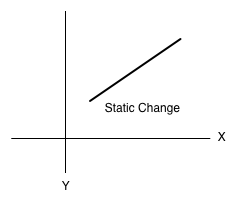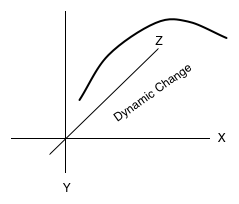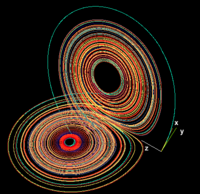Three Types of Change
Human Systems Dynamics posits three types of change: Static, Dynamic, and Dynamical.
I’ve summarized the differences in the types of change in this table. The descriptions come from HSD. I added the equations (for us math/engineer types) and the graphs of what the change might look like.
Let The Mess Begin!
So what happens? Some executive, somewhere, decides things need to change! People get assigned to new departments or teams. A new reporting structure gets defined. The charts are drawn, powerpoint slides created, and “all hands” sessions scheduled. (Using the Change… post, what model is management using?) The mess starts shortly after the meetings.
In my experience managers usually expect static change behavior. Start here. Go there. Done. You’re in a new team. We moved your equipment and materials to the new space. What’s the problem? Other than everyone having to work through the Change Model?
Some people will work through the Change Model quickly. But As Mike points out: “On many levels we are dealing with very personal deep seated stuff… the stuff that anchors us as people and defines who we are in relation to the world.”
This means other people will respond in a Dynamical fashion.
And hence the mess. The mismatch between the change response expected and the change response in the domain.
Productivity goes lower than it needed to. People get labelled “resistors”. Malicious compliance might occur. Management pushes harder to make sure the change happens.
If the wheels don’t spin completely off the change, it could get sidetracked. Sometimes management declares success and moves to the next hot topic.
As a change artist, I’m pro-change. Change includes planning.
As a systems thinker, I’m pro-models. Models are neither naughty nor nice. They’re the simplification of the world we carry in our head that enable us to function.
As an engineer, I’m pro-reality. In this case I define reality as using data to determine if our models reflect what’s happening the domain.
What to Do?
If you’re planning or involved with a change:
- Remember everyone goes through the Change Model. At different rates, but everyone goes through.
- Be prepared for the Failure Paths.
- Check your assumptions on the type of change you’re working with.
If you’re not sure what’s happening, you can engage a change artist to help.
The equations for the Lorenz attractor (the picture for dynamical change) came from
https://en.wikipedia.org/wiki/Lorenz_attractor. The picture of the Lorenz Attractor is from Wikimedia commons – Lorenz_Ro28-200px.png



